Kimono: Kyoto to Catwalk, is a big kimono book with beautiful photography and smart text — a must read for anyone who loves textiles and fashion history. It is the official exhibition book for the V&A Museum exhibit of the same name, which ran from 27 Aug 2020 to 25 Oct 2020. Unfortunately, I wasn’t able to travel to London to catch the exhibit, but the book makes up for that — well, maybe just a tiny little bit, as I think it would have been a wonderful experience to see these garments in person!
‘Kimono’ simply means ‘the thing to wear’. The garment was originally known as a ‘kosode’, meaning ‘small sleeves’, a term that referred not to the overall size of the sleeve but to that of the sleeve opening, which was just wide enough for the wrist and arm to pass through.

An example of a furisode kimono (kimono with elongated sleeves) made with yuzen and kata-yuzen dying and stenciling techniques. From the early 1900s, designs were bolder and more vibrant during this time compared to earlier periods. Image from here
Art as Fashion
One observation that stood out for me was the difference between western and Japanese aesthetics. Western fashions tend to emphasize the wearer’s shape and accentuate certain areas of the body, such as the waist, bust, or hips. Corsets, shoulder pads, and other devices have been used to create desired body shapes that are in line with what is fashionable at a given time.
But the shape of the kimono has changed very little over the centuries. Rather than emphasizing the wearer’s shape, the kimono’s flat, straight panels of fabric are the perfect canvas for showcasing dyed, hand-painted, or embroidered designs. The color and designs on the kimono reflect the fashion and taste of different periods of time.
A woman was judged not so much by her physical appearance as by her dress.
Rise of Kimono Culture
The kimono book includes a lot of historical detail that places the kimono within the context of time and place.
During the Edo period in Japan (1603 to 1868), the Tokugawa family ruled Japan as a military dictatorship (Tokugawa Shogunate). Under their rule, the period was characterized by economic stability, political peace, closed borders, and rise of the merchant class, all of which allowed kimono culture to grow and flourish.
The Tokugawa Shogunate enforced a strict social order, with the samurai class at the top, followed by farmers, artisans, and merchants. Farmers were higher in social status because they grew food (but were heavily taxed and therefore generally poor) while merchants were at the bottom because they didn’t produce anything (but were able to gain wealth).
As the artisan and merchant classes became wealthier, they had more income to spend on entertainment and extravagant dress. To counter this, the government enacted sumptuary laws to restrict non-samurai classes from ostentatious shows of wealth. Because outward displays of luxury were banned, many wore plain kimono with fine silks and embroidered garments hidden underneath.
The merchants and artisans, who lived in towns, also spent their money on entertainment and entertainers. As a result of their patronage, the following became known as the fashionistas of the Edo period: courtesans and geisha, Kabuki theater actors, and male actors/prostitutes.
Celebrated courtesans were major public figures and the real trendsetters of society, providing models of the most elegant and up-to-date style and taste. Prints of known courtesans wearing the most fashionable kimono served as wonderful publicity for brothel owners and clothing merchants alike.
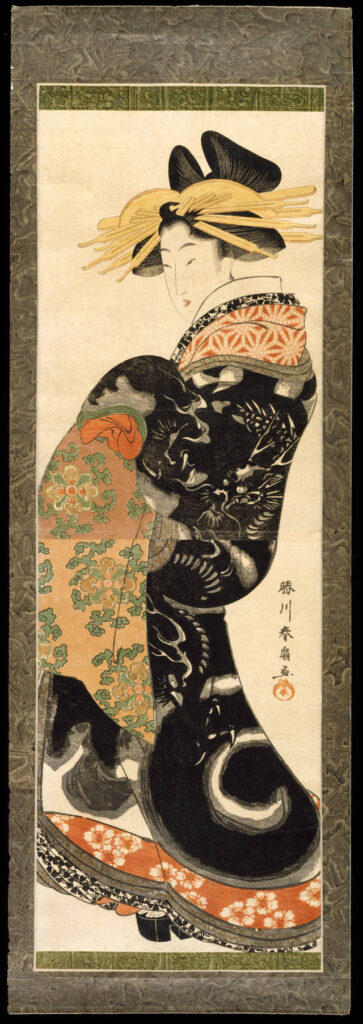
A woodblock print of a parading courtesan wearing many layers of kimono and a large obi tied in front, which was a specific style worn by courtesans (obi are typically tied in back). Early 1800s. Image from here
Kimono as Couture
As disposable incomes and demand for luxury goods grew during the Edo period, kimono merchants rose to prominence. They developed a process of selecting and ordering custom-made kimono that mirrors how couture clothing is made today. I thought this process was so fascinating, as the finished garment is truly custom and couture!
In 1666, the first hinagata-bon, or picture book, was published. Like fashion magazines today, hinagata-bon depicted new kimono designs meant to inspire new orders. As shown below, the artistic designs on the kimono — and not the silhouette of the kimono on the wearer — are highlighted.

Pages from a hinagata-bon from 1713. Image from here
Once designs and specific customizations were selected, the kimono merchant acted as a go-between with weavers who wove the fabric; workers who loosely sewed the woven fabric together before the artists could drawn an outline of the selected design and separated the pieces afterward; specialist artisans who dyed the pieces and added embroidery; and finally workers who sewed the kimono together. The finished kimono was then inspected, an invoice sent, and the final piece delivered.

A woodblock print of an attendant showing fabrics delivered from a kimono store to her mistress. From 1847 – 1850. Image from here
Foreign Influences During the Edo Period
In 1543, two Portuguese sailors landed on an island in southern Japan when their ship was blown off course by a typhoon. They were the first Europeans to arrive in Japan. For nearly 100 years afterward, Portuguese, Spanish, English, and Dutch traders and Christian missionaries developed relationships with the Japanese.
However, when the Edo period began under the Tokugawa family, suspicions grew about Christianity and the threat it posed to Japanese society. Missionaries and Japanese converts were persecuted and executed. In 1639, a closed country (sakoku) policy was enacted, which resulted in the expulsion of the Portuguese, Spanish, and English.
Curiously, the Dutch were the only Europeans allowed to remain (perhaps because they were seen to be more interested in business than religion) and continue trade relations until Commodore Perry opened trade with Japan to the world in 1854.
Textiles were popular trading goods during this time. Silks from China and India, silks and brocades from France, and cotton textiles from India appeared in Japan. Block-print fabrics from southeast Asia known as “sarasa”, which were prized for their colorful and exotic patterns, were especially fashionable but expensive. Stripes and checks were also popular patterns that were made into kimono during this time.

The bold black and white check fabric came from the Coromandel Coast (India) and was a fashionable look, especially when paired with an obi made of gujarati cotton fabric from India. From 1825 – 1835. Image is a photograph taken from Kimono: Kyoto to Catwalk.
Influence on Global Fashion
In the late 1800s, kimono were more broadly introduced to the world and the impact on global fashion became apparent. Interest was so high that Japanese makers redesigned kimono styles specifically for export and the country became the largest silk exporter in the world.
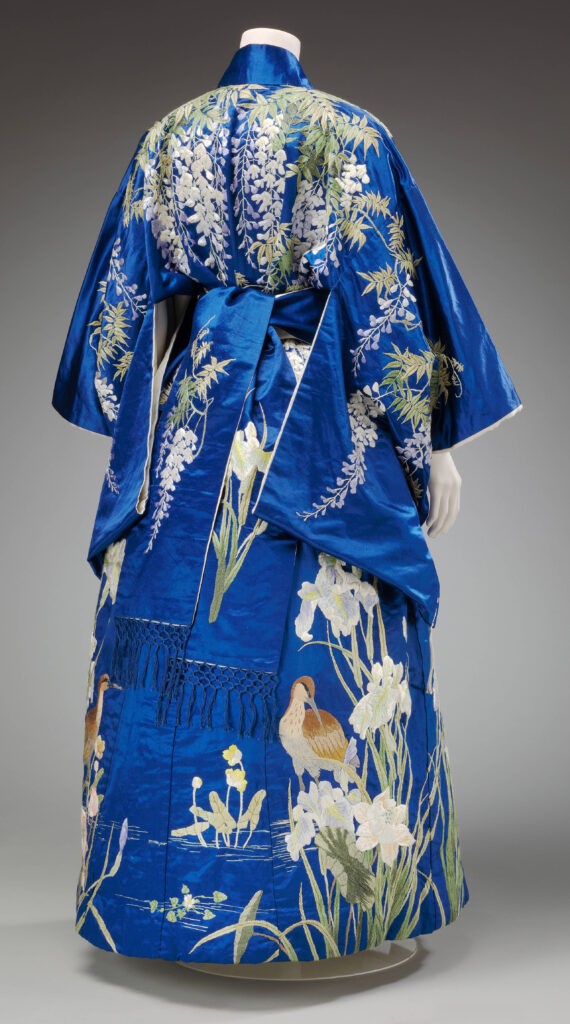
This kimono made for export to the West uses a fringed self-fabric sash instead of an obi. It also includes more fullness in the skirt rather than the traditional straight silhouette. Robe with sash from 1905 – 1915. Image from here
The kimono’s popularity in the early 1900s coincided with fashion’s move away from restrictive clothing (goodbye, corsets!). Designer Paul Poiret was instrumental in reimagining western clothing based on kimono concepts. He focused on draping and creating looseness around the body, rather than using structured tailoring techniques and relying on corsets to shape the body.
In kimono, the fulcrum of the garment is placed on the shoulder, not the waist, with the falling fabric wrapping the body loosely.
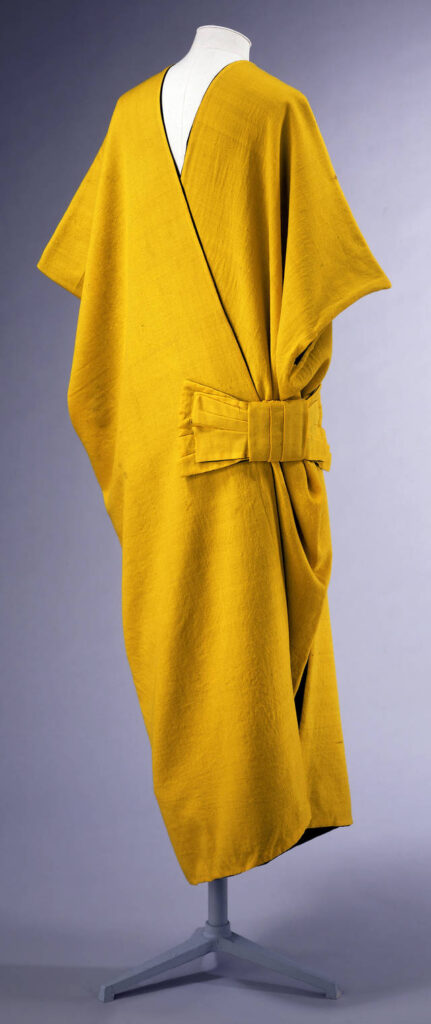
Mantle made from two rectangular panels by Paul Poiret. From about 1913. Image from here
By the 1920s and 1930s, the kimono’s simple forms and straight lines were strong influences on art deco and modernism in dress. Below is one of my favorite garments from this period.
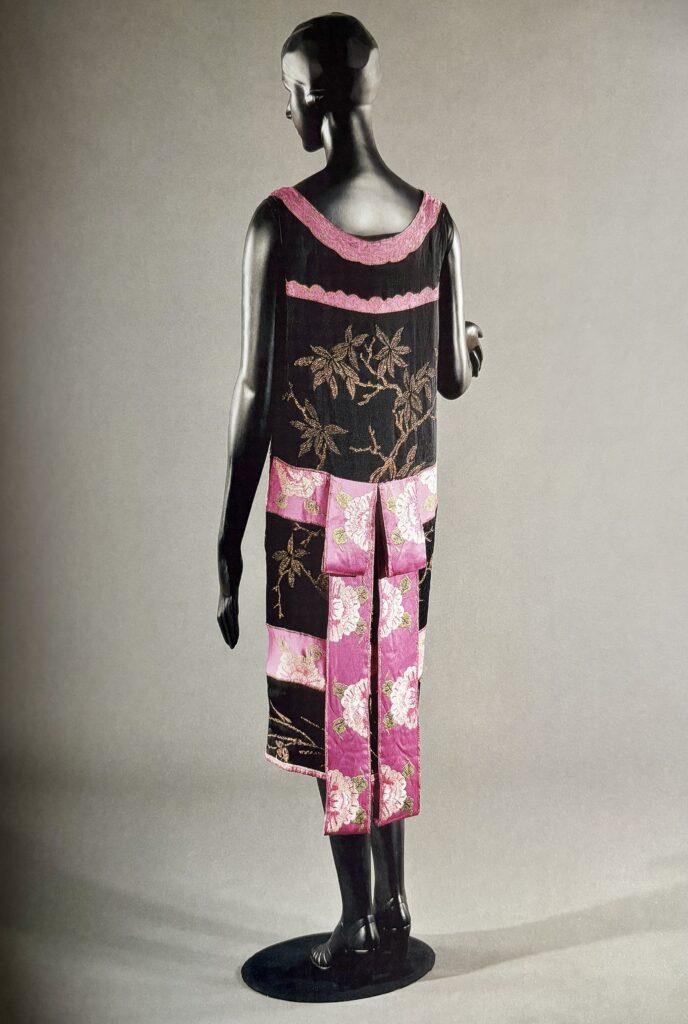
Evening dress by Callot Soeurs from 1922 – 1924. Image is a photograph taken from Kimono: Kyoto to Catwalk.
In Japan, foreign influences were seen in kimono styles from the early 1900s. In the image below from the 1930s, the woman is wearing a boldly patterned and colored kimono accessorized with a fur stole and a clutch bag. She is also wearing makeup and has manicured nails. Very modern!
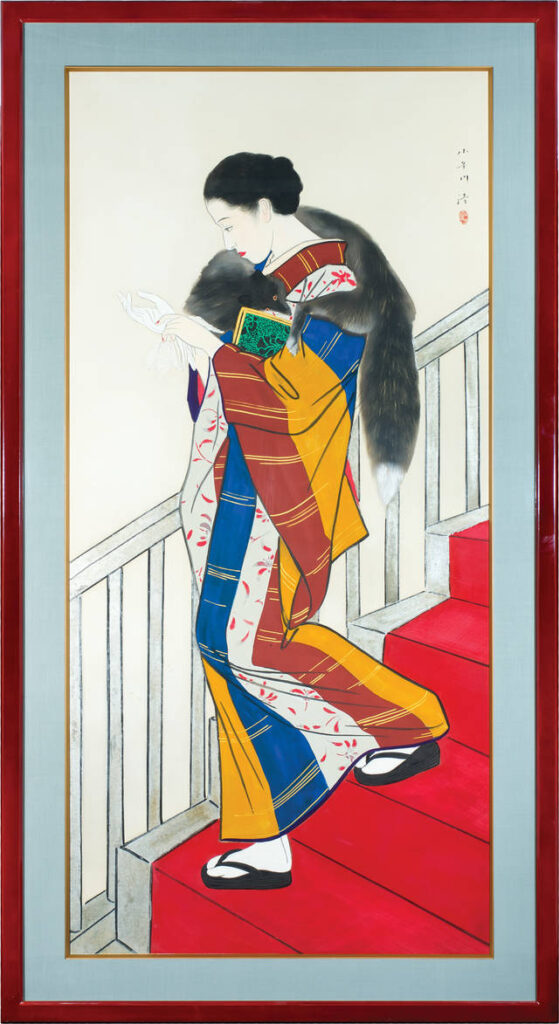
From 1935. Image from here
After World War II, the kimono transitioned from everyday wear to special occasion wear in Japan, but the kimono continues to be a strong influence on fashion around the world.
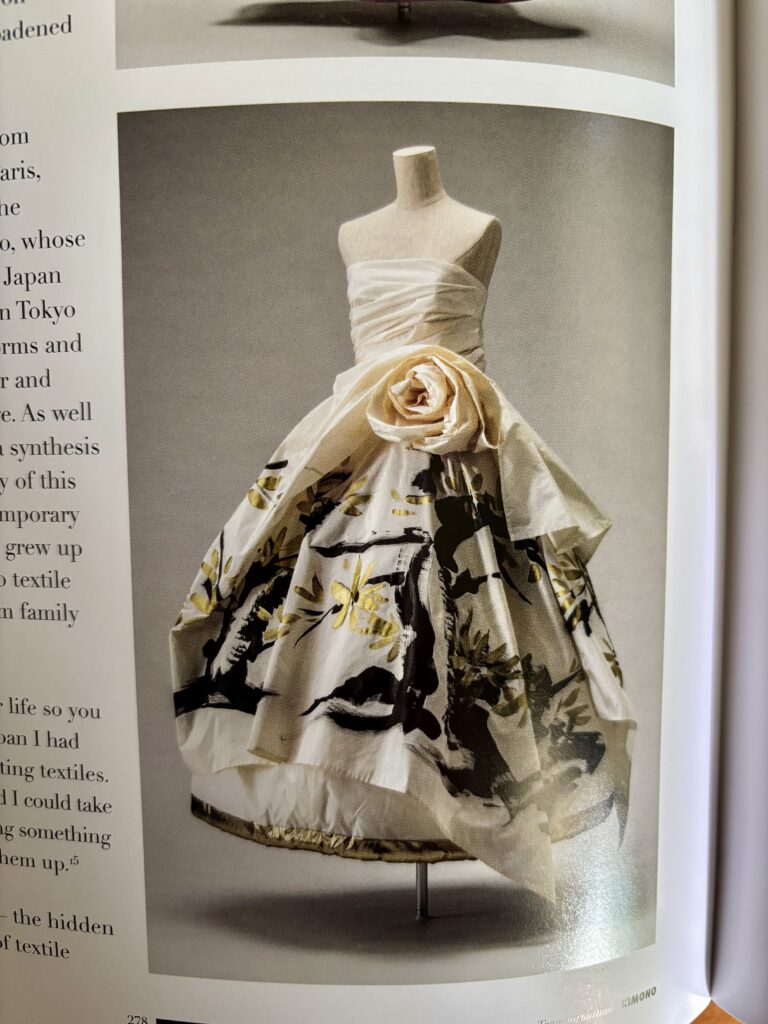
Evening dress by Rei Kawakubo from 1991. The details are reminiscent of Edo period designs, such as the gold and black handpainted brushwork and the padded hem of the underskirt (technique seen on uchikake kimono styles). Image is a photograph taken from Kimono: Kyoto to Catwalk.
Kimono Book References
The following series of links are for a wonderful set of videos produced by the V&A Museum that walks viewers through the Kimono: Kyoto to Catwalk exhibition.
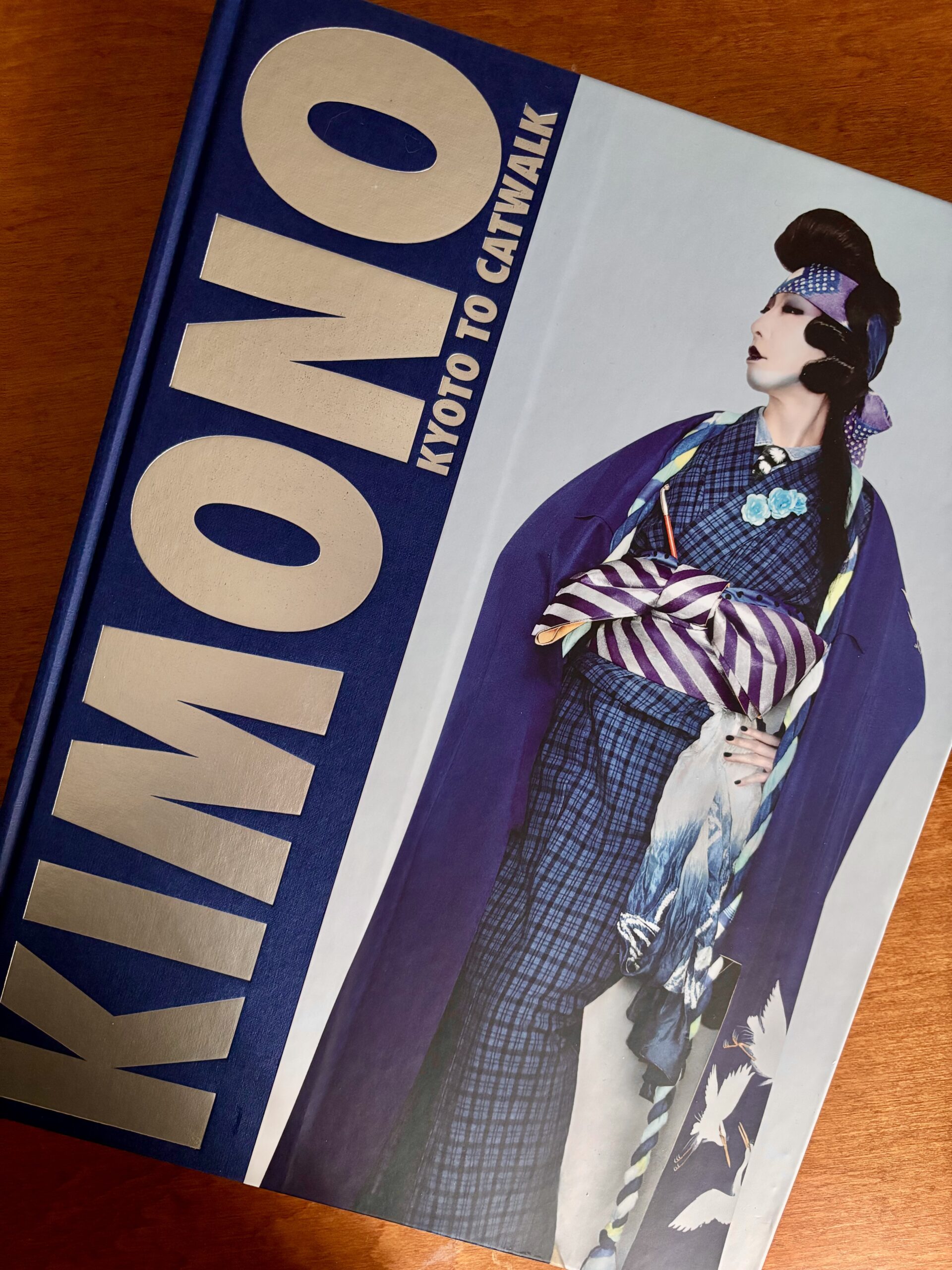
Leave a Reply